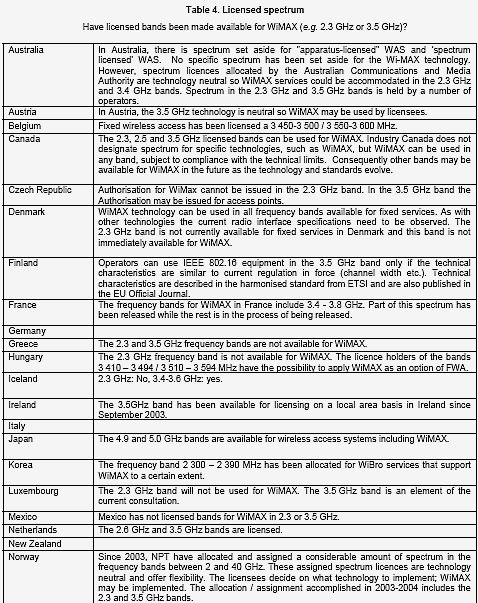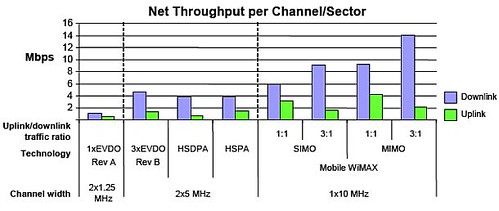Battle for Britain
The always cogent Caroline Gabriel says the UK’s upcoming auction of 2.6GHz mobile broadband spectrum is intensely anticipated, partly because it is the first major European market to make the move. But also because it represents the best chance for a WiMAX operator to gain a national license in a leading EU economy.
The UK 3G operators have no particular desire to see an early auction. If BT (or another bidder from outside their ranks) does win spectrum, they will have to face yet another competitor. And they do not have an urgent need for 2.6GHz themselves–most are just rolling out HSPA and the 3G networks are not at capacity.Since the five cellcos will almost certainly use LTE if they get 2.6GHz licenses, they will not be able to start build-out for at least another 18 months.
For WiMAX vendors, a delay in this flagship auction would be a major blow. To get any inroads into mature mobile markets, WiMAX needs to exploit its headstart over LTE, especially since the two technologies are very similar in what they actually deliver.
Upcoming 2.5 GHz Spectrum Auctions (2008)
SOURCE: WiMAX Day
Date Frequency Country Regulator Q1 2008 2.5 ~ 2.69 GHz UK OFCOM Q2 2008 2.5 ~ 2.69 GHz Austria RTR Q2 2008 2.5 ~ 2.69 GHz Sweden PTS Q2 2008 2.5 ~ 2.69 GHz Ukraine NKRZ Q2 2008 3.4 ~ 3.69 GHz Chile SUBTEL Q3 2008 3.4 ~ 3.69 GHz Brazil Anatel Q4 2008 2.3 ~ 2.39 GHz Hong Kong OFTA 2009 - 2010 2.5 ~ 2.69 GHz Hong Kong OFTA The incumbent telco, British Telecom, has no mobile arm, which makes it likely to bid for a license. If it does and it wins, BT is likely to adopt WiMAX rather than LTE to take advantage of the headstart WiMAX would provide.
The advantage is pointless if potential customers cannot get their hands on suitable spectrum. If the operators have to wait for a year or more for auctions, the playing field with LTE will have levelled, even for non-3G carriers.

It will be the UK’s single-largest release of radio spectrum to date, suitable for a range of new services such as mobile broadband and advanced wireless services delivered using WiMAX and 3G technology.
Ofcom will release the spectrum in the 2010-2025 MHz and 2500-2690 MHz bands on a technology and service neutral basis. In total, 205 MHz will be available and Ofcom expects to start the auction process in the summer.
Meanwhile, Clearwire this week praised the European Commission’s decision of May 21, 2008, aimed at harmonizing the availability and efficient use of 3400 ~ 3800 MHz frequencies in Europe. The EC will require Member States to quickly move to allow mobility in these frequency bands.
“The Decision is meaningful for Clearwire’s European operations, where we widely utilize 3.5GHz spectrum,” said Benjamin G. Wolff, chief executive officer of Clearwire. “With extensive holdings in Belgium, Germany, Ireland, Poland, Romania, and Spain, and our affiliate’s holdings in Denmark, our licenses cover more than 200 million people throughout Europe”.
“Clearwire fully supports the Commission’s view that as mobile wireless broadband services become the primary service used with this spectrum, further harmonization will favor pan-European roaming amongst these frequencies.”
 WiMax hopefuls in the U.K. may find themselves shut out of the 2.6 GHz auction by the Office of Communications, says Unstrung. Five mobile operators are potentially bidding to hoard WiMax spectrum. Ofcom will auction 2010-2025 MHz and 2500-2690 MHz bands (known as 2.6 GHz) on a technology and service neutral basis.
WiMax hopefuls in the U.K. may find themselves shut out of the 2.6 GHz auction by the Office of Communications, says Unstrung. Five mobile operators are potentially bidding to hoard WiMax spectrum. Ofcom will auction 2010-2025 MHz and 2500-2690 MHz bands (known as 2.6 GHz) on a technology and service neutral basis.
Ofcom has allocated a certain amount of licensed spectrum for time division duplex (TDD), or unpaired spectrum, and a certain amount FDD, or paired spectrum. Analysts and WiMax players expect the U.K.’s mobile operators to buy up the TDD spectrum to keep out new Mobile WiMax competitors.
 Meanwhile, in the UK, businesses using British Telcom’s Business service can now turn their BT Business Hub into a BT Openzone wireless hotspot at no cost. This will allow anyone visiting their premises to log on to a separate secure internet channel. When a new version of the BT business hub comes out in July, it will come with the hotspot feature built in.
Meanwhile, in the UK, businesses using British Telcom’s Business service can now turn their BT Business Hub into a BT Openzone wireless hotspot at no cost. This will allow anyone visiting their premises to log on to a separate secure internet channel. When a new version of the BT business hub comes out in July, it will come with the hotspot feature built in.
There are already 2,500 BT Openzone Premier hotspots at hotels, airports, railroad stations and other sites, plus hotspots covering the centers of 12 cities in the UK. There are also some 70,000 BT consumers have joined the BT FON Wi-Fi community, BT said.
The 2.5 GHz spectrum profile is considered to be the “sweet spot” for many of the world’s initial deployments for mobile WiMAX, including Japan, Taiwan, and the United States.
The 2006 AWS auction in the United States was billed as broadband spectrum for all Americans, but essentially was crafted for San Antonio-based SBC which needed “3G” spectrum. The company later acquired AT&T Wireless, then AT&T Wireless, Verizon Wireless and T-Mobile bought billions worth of AWS spectrum (1.7/2.1 GHz) which will likely be used for LTE in the United States.
Juniper Research predicts 24 million LTE (Long Term Evolution) subs by 2012.
Senza Fili Consulting expects only 54 Million WiMAX Subscribers by 2012 while the WiMAX Forum projects more than 133 million WiMAX users globally by 2012.
ComputerWorld compares WiMAX with LTE, but overlooks a couple of key points. First, the bandwidth available on 700 MHz (12 Mhz) is limited and the 100Mbps figure does not apply. Clearwire and Sprint have some ten times that bandwidth at 2.5 GHz. Secondly, ComputerWorld indicates WiMAX is two years away with LTE 3-4 years away from mass deployment. It will take a long time to deploy LTE networks nationwide, and Mobile WiMax is commonly believed to have a 2-4 year advantage. The figures supplied by Gartner analyst Phillip Redman and quoted by ComputerWorld are debatable.
Verizon spent over $45 billion on EV-DO over the last eight years. Everything must go with LTE.
Sprint has 90MHz of 2.5GHz spectrum, covering 80 markets which it picked up for a song. Clearwire’s CEO Ben Wolff says it will reach 120 million to 140 million people by the end of 2010, before LTE even gets started. An LTE upgrade ($100K), on 50,000 AT&T towers will be a lot more expensive then WiMAX — it might cost upwards of $50B. Even if you had a “standard” and spectrum and handsets and backhaul. WiMAX will come “free” with most laptops.









[get this widget]




